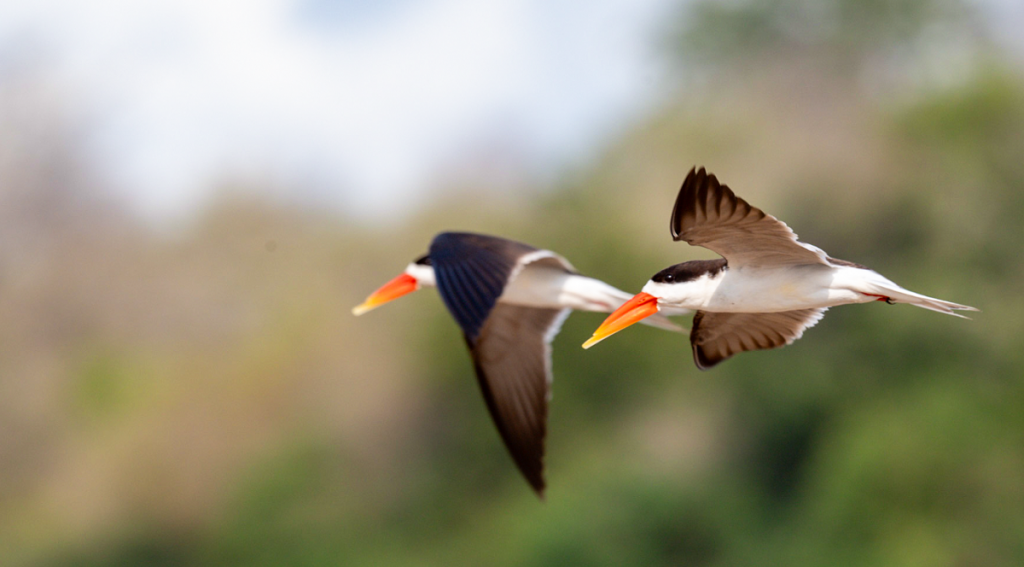Beautiful Birds of Africa: Part 2
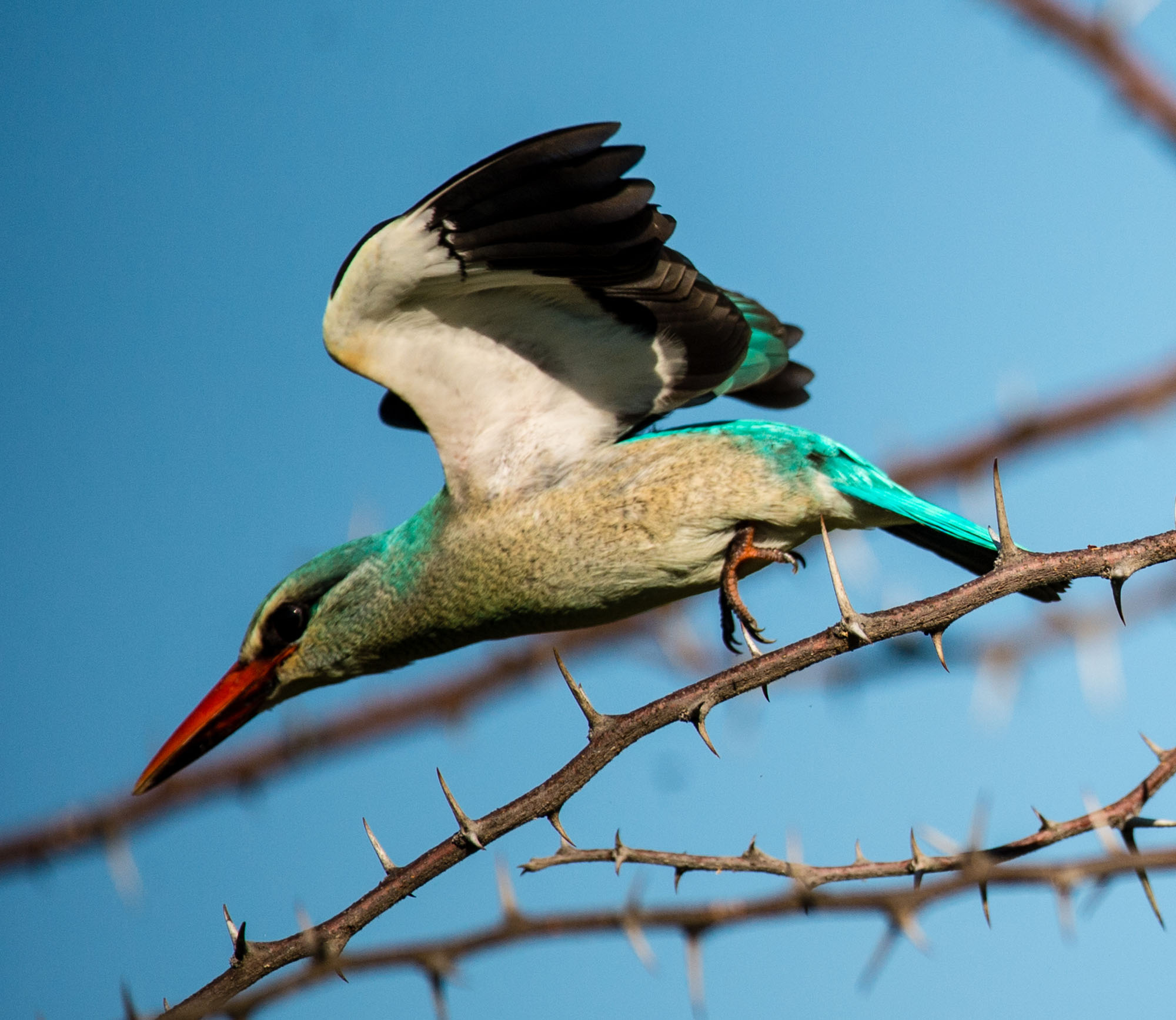
Beautiful Birds of Africa: Part 2
Other than being pretty, or striking, or even awesome to see, birds intersect with the safari experience in several ways.
Practically anywhere you go on safari, there will be a dawn chorus. More than any other destination you could travel to, Africa is where you hear birds more often, and earlier. Well before first light, and long before the sun actually appears, the first sounds heralding the new day start to pop up. Far away in the distance you might hear the chirp-like call of an African Scops Owl, to be answered a few seconds later by another owl. Then, depending on the habitat, the small, colorful birds which inhabit the dense thickets and edges of wetlands – where many camps are located – swing into action.
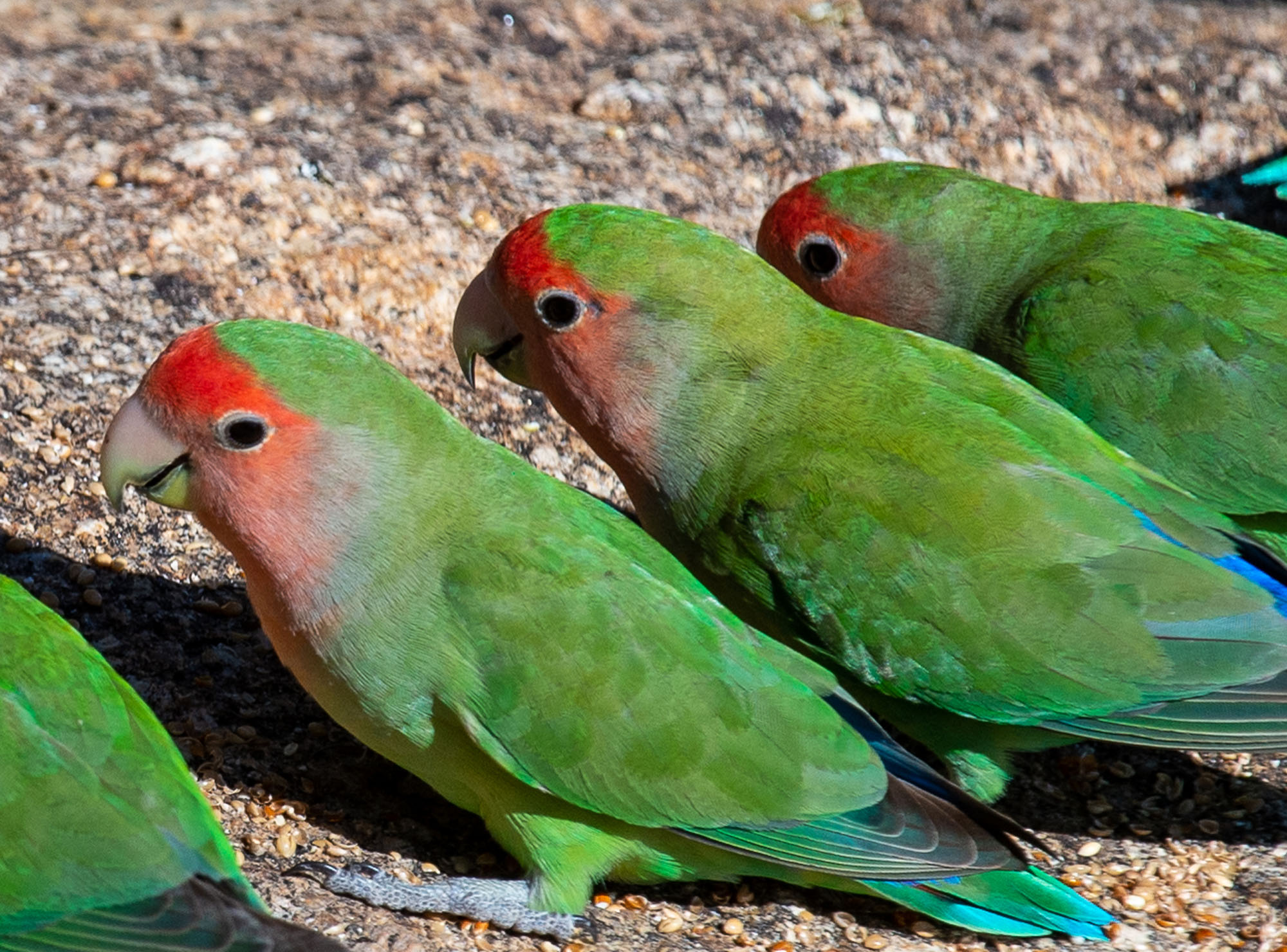
Remarkably loud for their size, species such as the Chorister Robin-Chat, White-browed Robin-Chat, Cape Robin-Chat, Gorgeous Bush Shrike, and other skulking species of the forest interior will get your attention. Sometimes earlier and more insistently than you might have liked. Later still the various Bulbuls, Doves, Hornbills and Go-Away-Birds chime in, so stick around. Around sunrise, it is not unusual to hear the raucous calls of Spurfowl and Francolins, sounding perpetually surprised and startled. With luck, you will wake up to the melodious call of a Whitebrowed coucal – sounding much like water bubbling from a bottle.
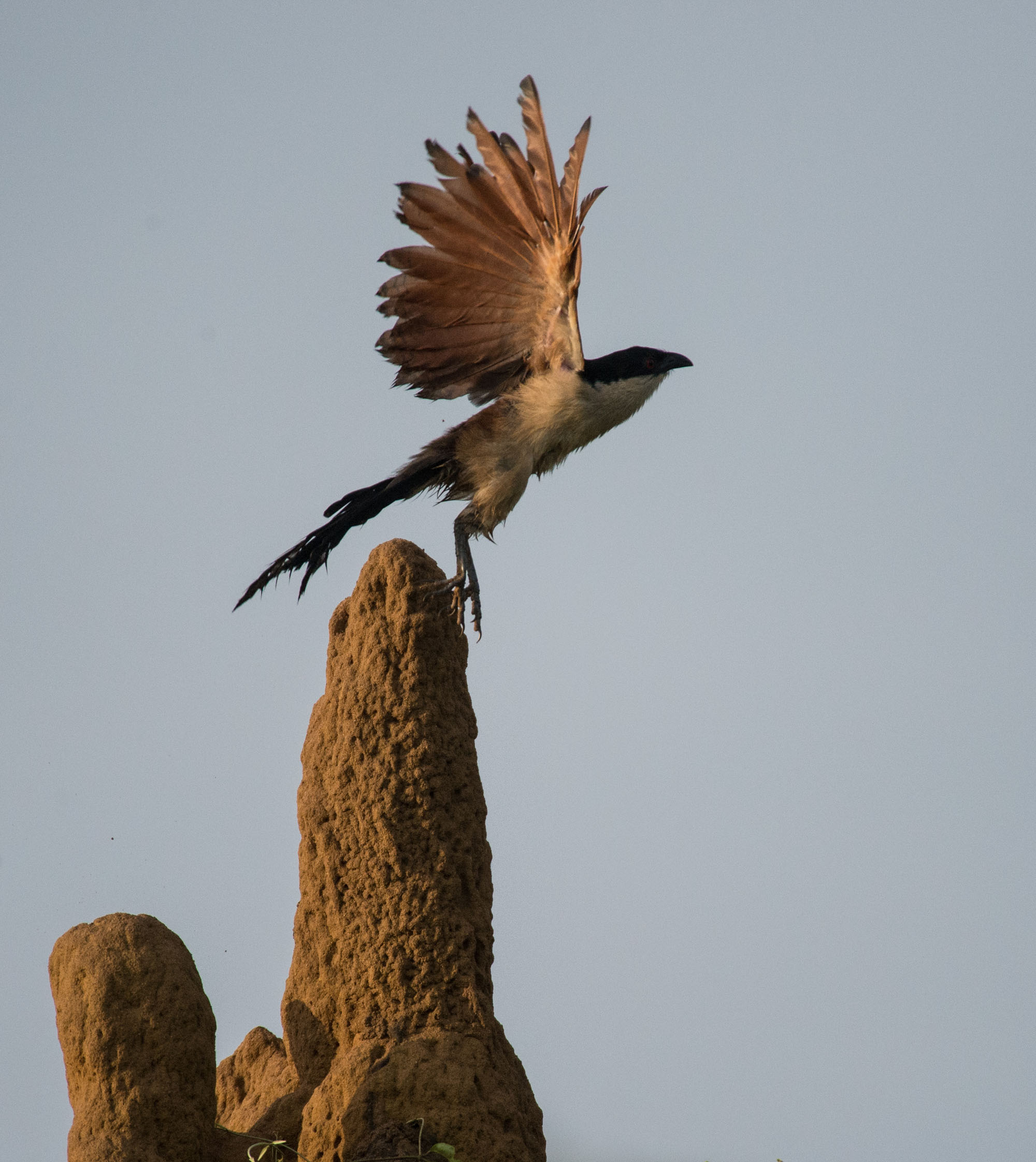
If you have a moment – when you’re not too busy getting ready for the morning game drive – this is the perfect time to take a seat on your verandah, with a cup or tea of coffee, and really immerse yourself in the sound and the place. This is when you might experience that most magical of safari phenomena, a sense of profound deja vu. Let your mind wander along with the view and the sounds of the African morning. Before long, you may experience a feeling of belonging, just as if you’ve been there before.

Perhaps this has something to do with Africa having been our ancestral homeland, or maybe it is just a reflection of mind and body feeling at peace in such an idyllic setting. It is even more likely to happen just after first light, with the soft morning sun rays gently lighting up the landscape. Whenever this happens to me – and I make a conscious effort to seek out suitable opportunities – it engenders a very powerful sense of belonging, and of being in a spot which feels just right. The space-time continuum is real.
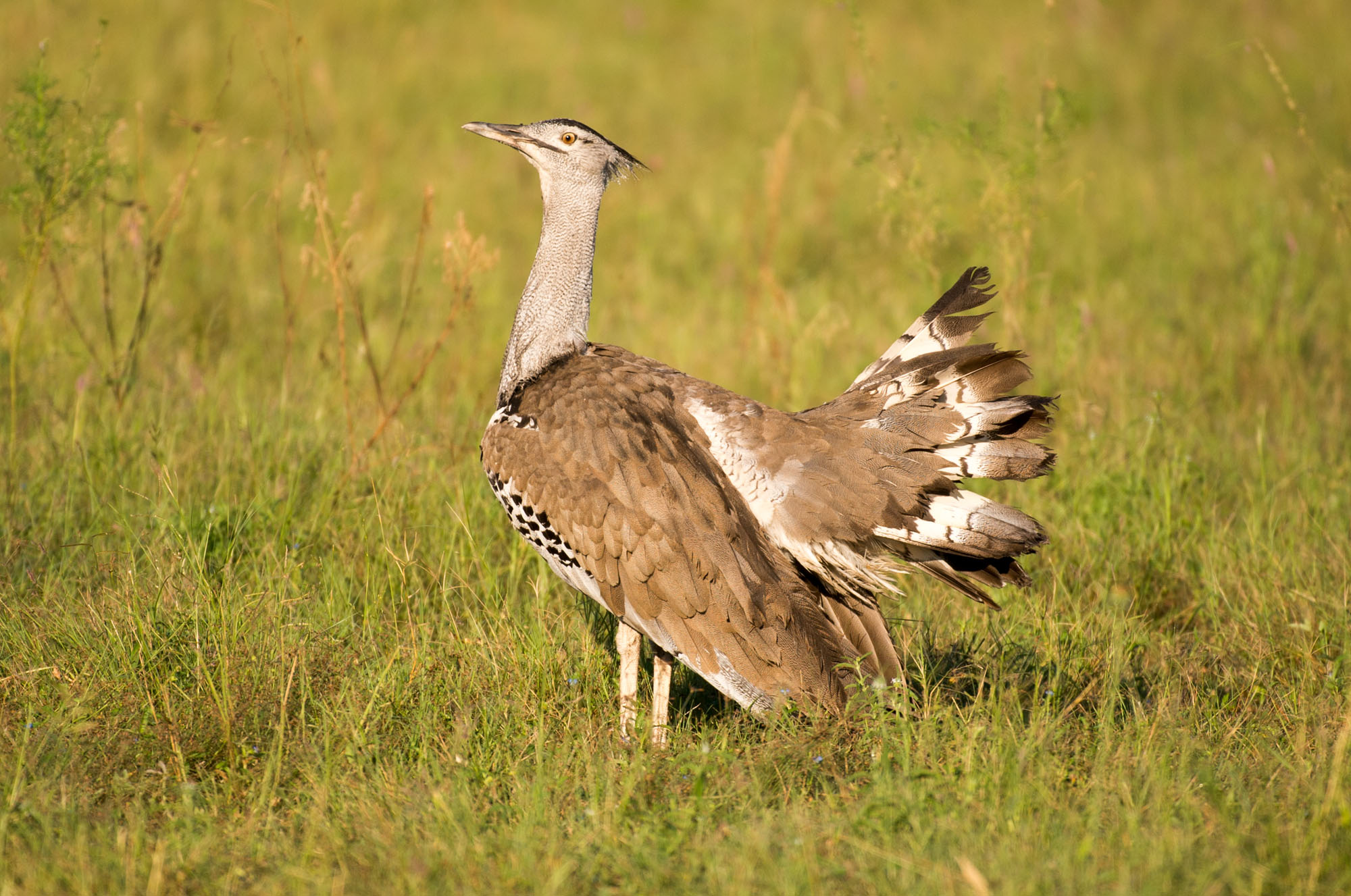
The Kori Bustard
One of the most fascinating birds you are likely to see in Africa is the Kori Bustard, widely considered to be the heaviest flying bird in the world. When the males are in full breeding display – with their white neck feathers distended into a prominent hemisphere – they are unmistakable and can be seen from more than a kilometer away. Kori Bustards are cryptically colored and blend incredibly well into a grassland habitat.
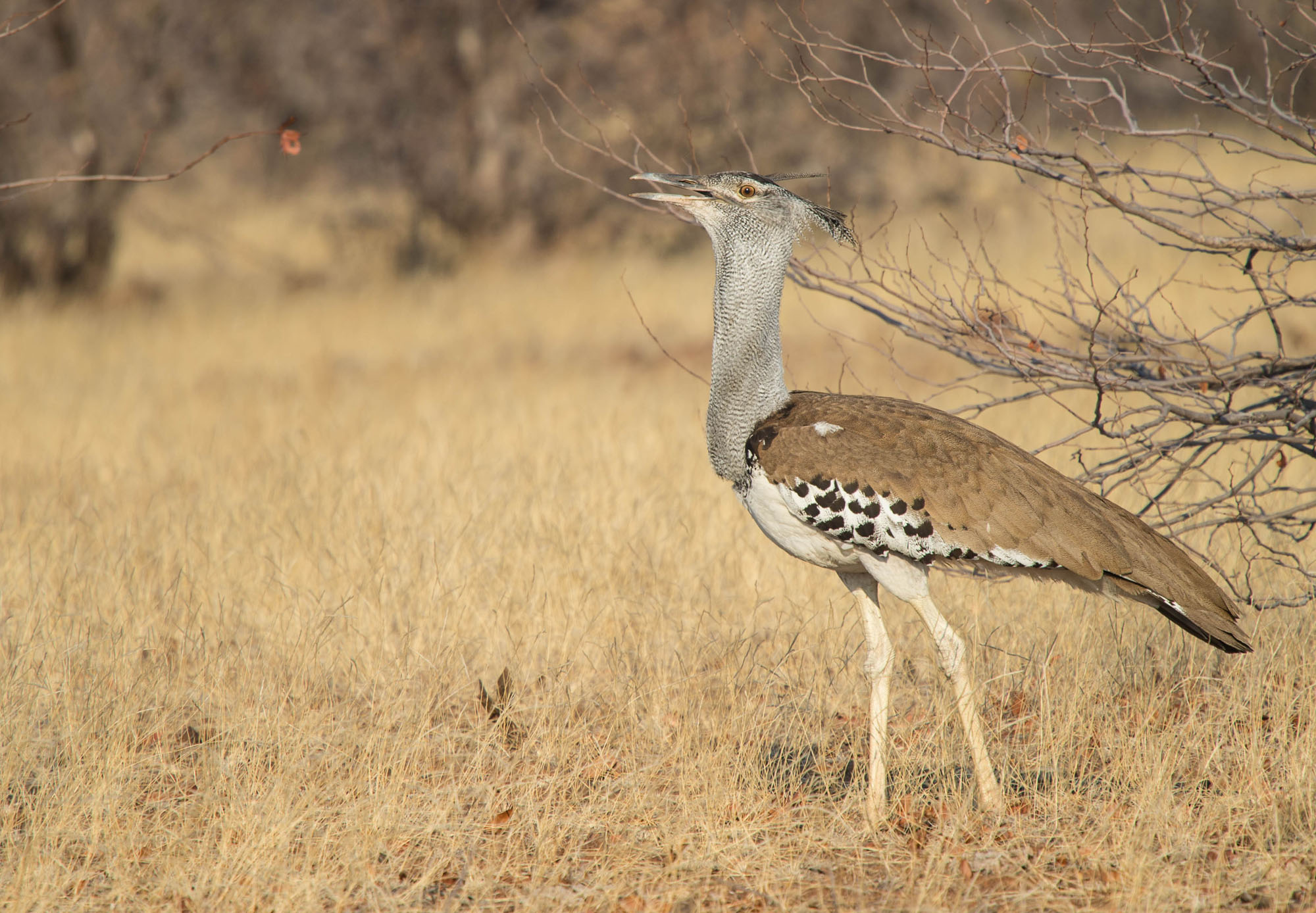
If you see one, start looking around and invariably there will be one or two others around, in the far distance. Koris are shy by nature and rarely allow vehicles to approach them closely. They are almost always walking away when seen, and it is tricky to get a good photo of a Kori Bustard head-on. I know 90% of my Kori Bustards shots show the birds side-on. Maybe trying to get a better angle on a Kori would be a nice challenge for a future trip!
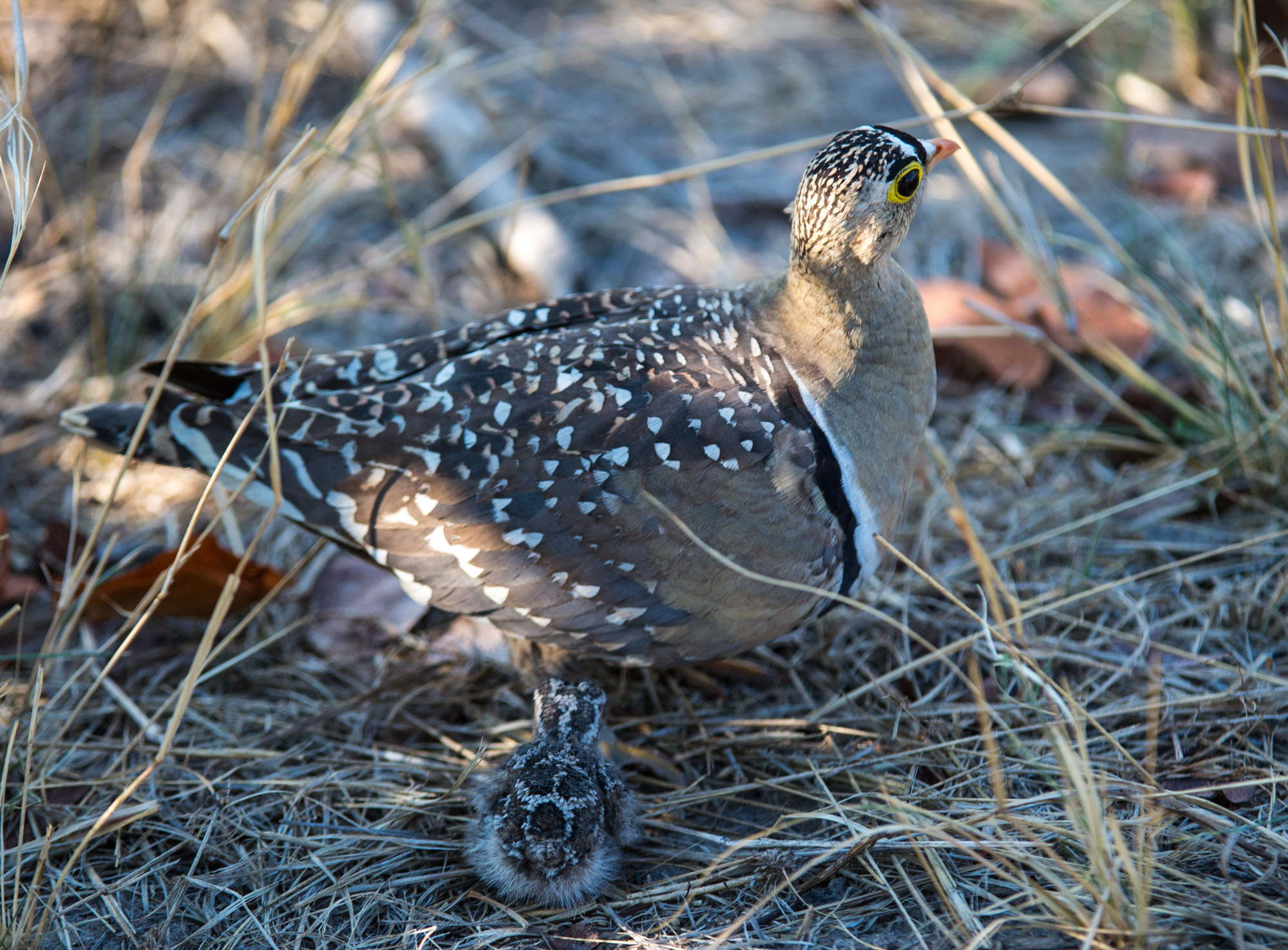
Sandgrouse
Sandgrouses are pigeon-sized birds which are often seen on the ground in sandy or gravelly terrain, in search of seeds, green shoots, leaves, bulbs and berries. There are 16 species of sandgrouse – mostly found in semi-desert regions of Africa – and many of them look alike. If you do happen to drive up to a few of them and they stay put, be sure to put the binoculars on them as their cryptic coloration conceal some beautiful neck bands, face patterns and breast markings.
Most sandgrouse species drink at dawn, others at dusk. Sometimes many hundreds or even thousands of them converge at a water hole, and it is a spectacle to see them swoop in to drink quickly (they can gulp up enough for 24 hours, in just seconds ) and then explosively fly away. Sandgrouses are at their most vulnerable while drinking, and it is not unusual to see a bird of prey such as a Sparrowhawk or Lanner Falcon lurking nearby or actually attacking them.
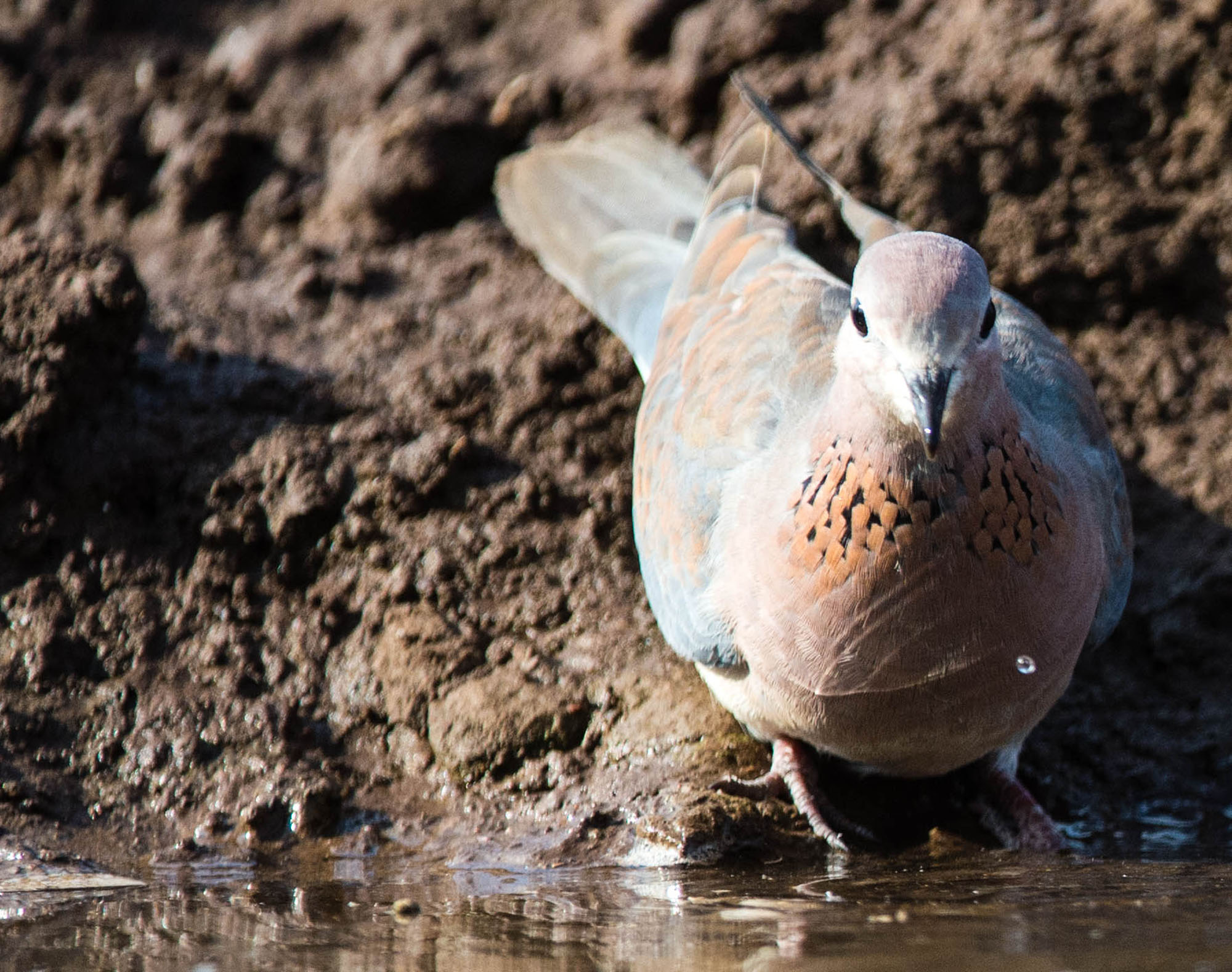
Pigeons, Doves and Parrots
If you’re driving through mature woodland savannah and hear the typical shriek of a parrot, you’re not imagining anything. That is a real parrot you are hearing. There are not many parrots in Africa – compared with South America for example – but there are a few and some of them are quite common and widely spread. These include the Brownheaded, Meyer’s and Cape Parrot, and the Rosyfaced, Fischer’s and Lilian’s Lovebirds. They are more often heard than seen, often just a flash of green disappearing into the treetops.
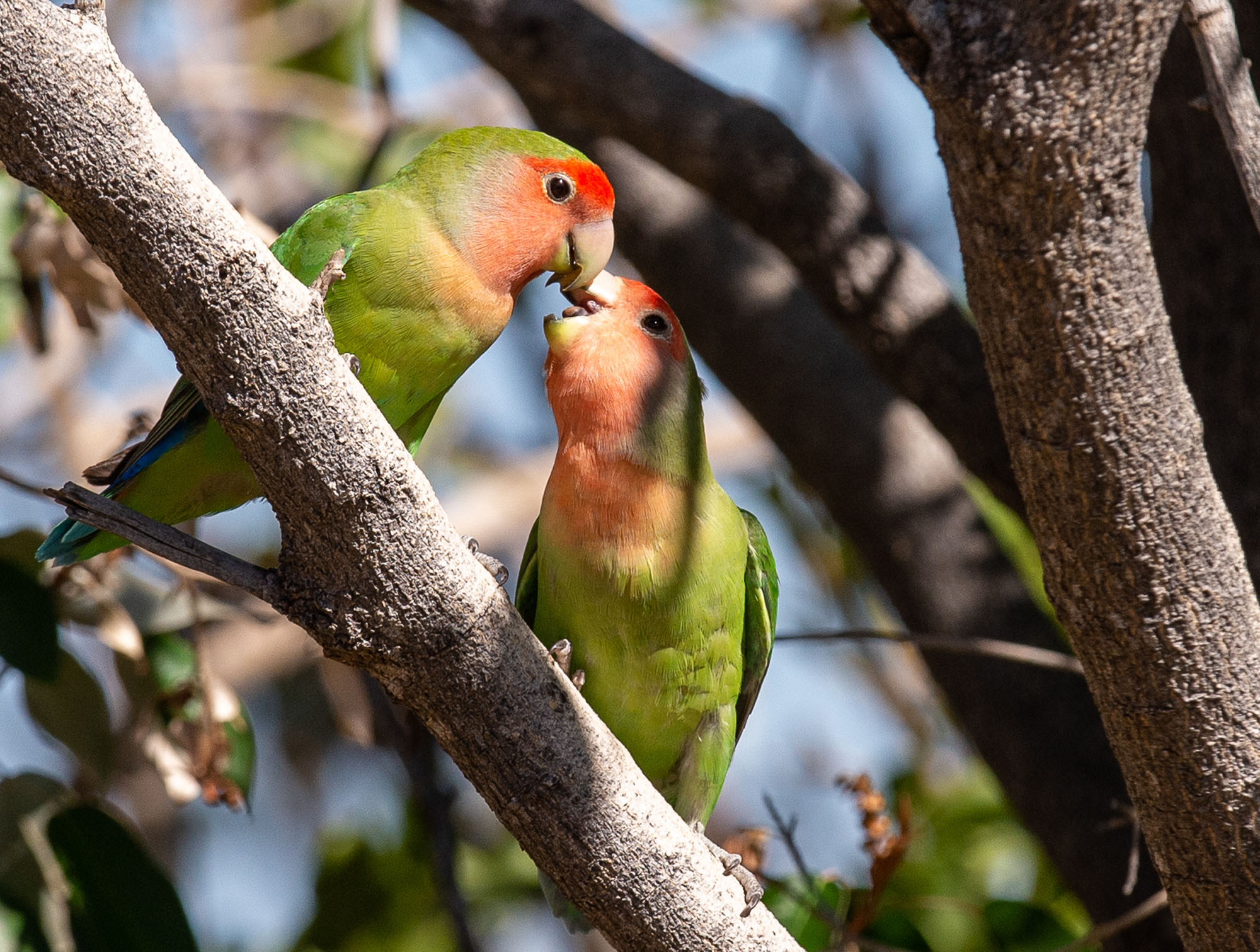
Pigeons and doves are a different story. They are abundant and usually quite confiding, but tend to blend into the background due to being so common. If you’ve seen one, you haven’t seen them all, by any means. The Green Pigeon – often seen within the canopy of wild fig trees – is a spectacular bird, when seen properly. So be sure to check for them and train your binocs on them. Their olive green and blue feather pattern and blue eyes are spectacular. With prominent red bill and feet, plus their peculiar pigeon-like foraging habits, they are worth seeking out.
Cuckoos
Cuckoos are common birds of the African bushveld, with many of them widely spread and quite visible in acacia thornveld. Several of the cuckoo species are summer migrants to Southern Africa, arriving around October and heading back up north around April or so. So if you are a keen birder, this is the best time to be in the region, to be able to see the cuckoos and many other summer migrants which include some shrikes, birds of prey, various wading birds, bee-eaters, orioles and others.
Cuckoos are vocal and often quite loud – sometimes annoyingly so as in the case of the Black Cuckoo. It can literally drive one insane with its drawn out, monotonous round-the-clock call: “I’m so S-I-C-K, I’m so S-I-C-K”. Paradoxically, some of the most well-known cuckoos – at least by their call – are almost never seen. The best example is the Redchested Cuckoo. It takes concerted, persistent effort on the part of any birder to actually see one of these pretty yet supremely elusive, raptor-like birds. For visitors, my best advice is: enjoy the call. ‘Piet my vrou, Piet my vrou!’
Coucals
Coucals are found all over Africa and in many cities like Johannesburg and Nairobi, they are common garden birds. Gardeners love them for their snail-eating penchant. In the wilderness, they are often seen skulking around thickets or on the edges of bushes, sometimes flopping from one low perch to another. They are not the best of flyers.
When seen well, Coucals remind one remarkably of their reptilian ancestry, looking for all the world like little miniature dinosaurs. The most commonly seen species is the White-browed Coucal. It looks just like the Burchell’s Coucal which looks just like the Copperytailed Coucal which looks just like the Senegal Coucal. One of the reasons, I guess, why birding is an acquired taste…
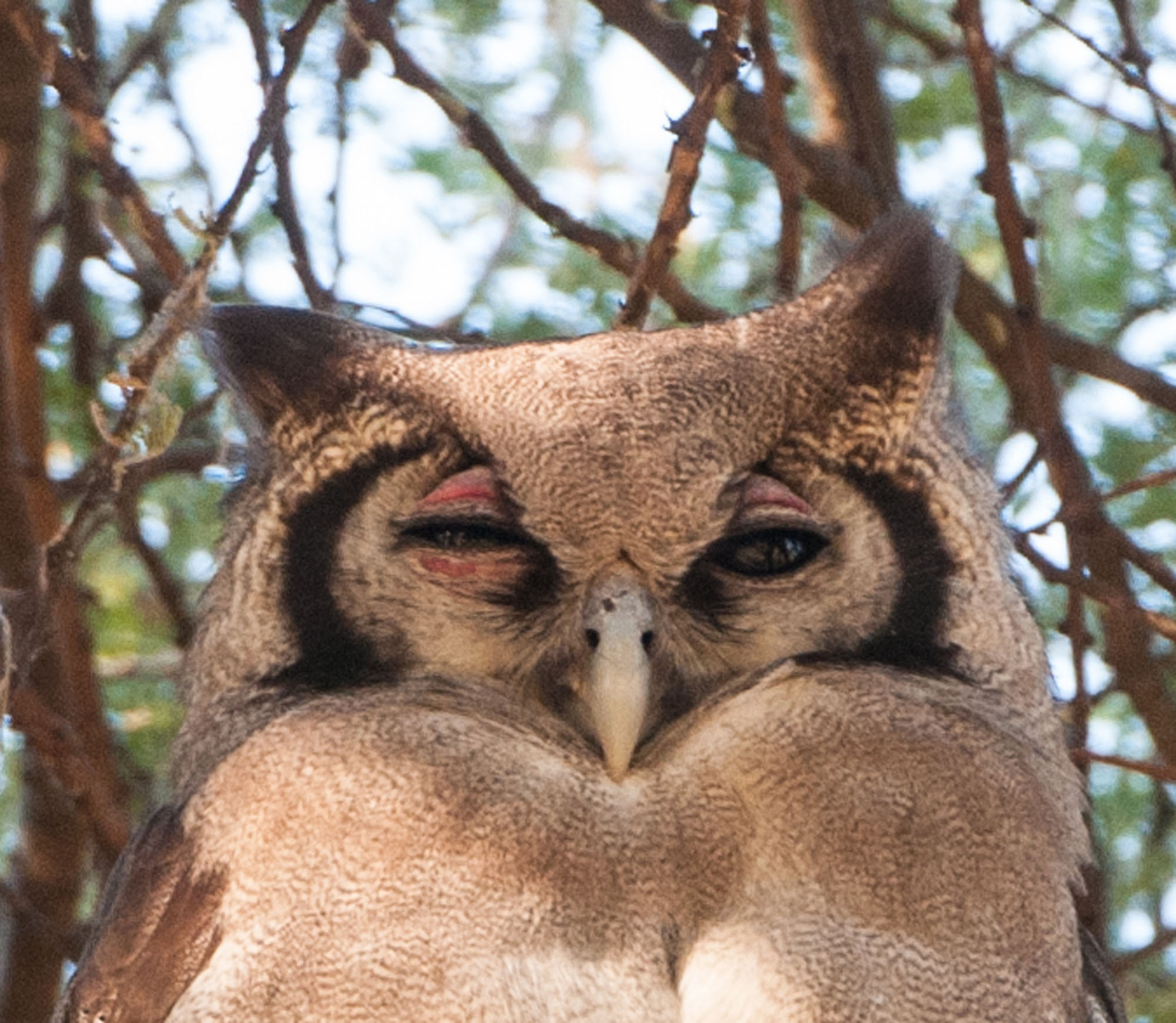
Owls and Nightjars
Seeing an Owl – anywhere – is a thrill. These quiet-flying, big-eyed, mostly nocturnal birds of prey have a special mystique attached to them. Their baleful stares, their haunting calls, their association with darkness, magic and mystery – everything about owls is weird and different. Africa has its share of owls and on safari there are many opportunities to mostly hear, but sometimes also see them. If you’ve ever been on an African safari you have likely already heard the call of the African Scops Owl. And if you are planning to go, you will certainly hear them, if you listen. Sometimes throughout the night, their chirping, insect-like calls penetrate the darkness, one answered by another. Over and over. As to seeing them, good luck with that…
Fortunately, there are many African owls that are not that difficult to see. The tiny Pearlspotted Owlet is one of them. This fearless creature – which can often be heard in a wide range of habitats, making its long, whistling call – is diurnal and is much despised by smaller birds. This often results in several small birds ‘mobbing’ a Pearlspotted Owlet, which attracts the attention of safari guides, and guests. Many guides are also capable of ‘calling up’ a Pearlspotted Owlet, by mimicking its call. When seen from behind, it has a false pair of ‘eyes’ on the back of its head, making it appear to be looking directly at you. The real purpose being to fool potential predators into thinking that they have already been spotted. Like other owls, a Pearlspotted Owlet is capable of turning its head about 270 degrees. Did we say that owls are weird?
Another relatively frequently seen African owl is Verraux’s Owl (Giant Eagle Owl), a massive bird which spends much of its day secreted in the mid to upper part of stands of large, leafy trees. Due to their sheer size, they are often spotted in this situation, or sometimes around dawn or dusk, when they tend to perch in an open spot, sometimes emitting their strange screeching call. When seen close up, their eye-lids are distinctively pink, yet another way to distinguish them from any other owl species.
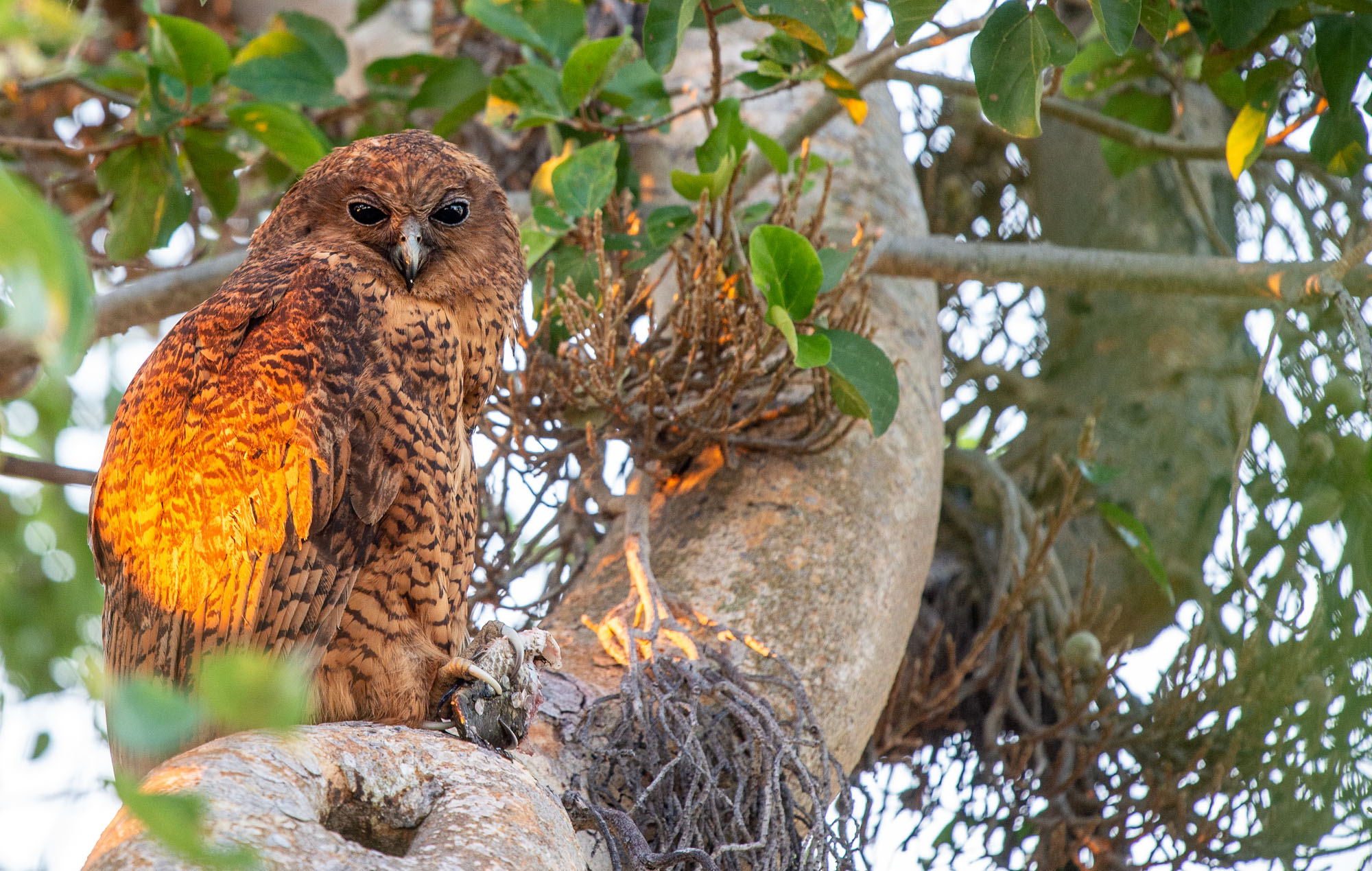
A highly sought-after African species of owl is a handsome, large brown to beautiful ginger-colored bird, the peculiar and very distinctive Pel’s Fishing Owl. It is most easily seen in the Okavango Delta in Northern Botswana, but is widely distributed in suitable wetland areas in Kenya, Tanzania and South Africa, such as along the Luvuvhu River in the far northern part of Kruger Park. Pel’s Fishing Owl is one of the few species of owls eating fish almost exclusively. It is rarely seen mostly because of its solitary and largely nocturnal existence, patrolling rivers and swamps in the dead of night. When seen, it is often hidden away in a dense thicket during the day, or close to a nesting site which may be a hollow or cavity in a big tree. On a recent trip I was fortunate to be in tent #4 at Wilderness Safaris’ Pelo Camp in the Okavango, where a pair of Pel’s Fishing Owls (they mate for life) were raising a young chick in a tree just meters from the tent.

As for nightjars, they are the African equivalent of the North American Nighthawk. The African birds are not usually seen hawking insects in a Target parking lot, of course. Rather, they are usually seen on the ground, at dawn or dusk, their cryptically colored feathers making them extremely hard to tell apart. All but a couple of species are practically indistinguishable from a distance, by all but the most expert of birders who put together the habitat, call (if heard), the known distribution of specific species and a few other clues, to come up with a name. The rest of us amateur bird-watchers and visitors will mostly have to be content with writing down “nighthawk species’ in our list of birds seen. You will most assuredly hear them though, at night. In fact, one of the most ubiquitous sounds of the Southern African bushveld night is the call of the Fierynecked Nightjar, a loud and instantly recognizable ‘Good Lord deliver us…’
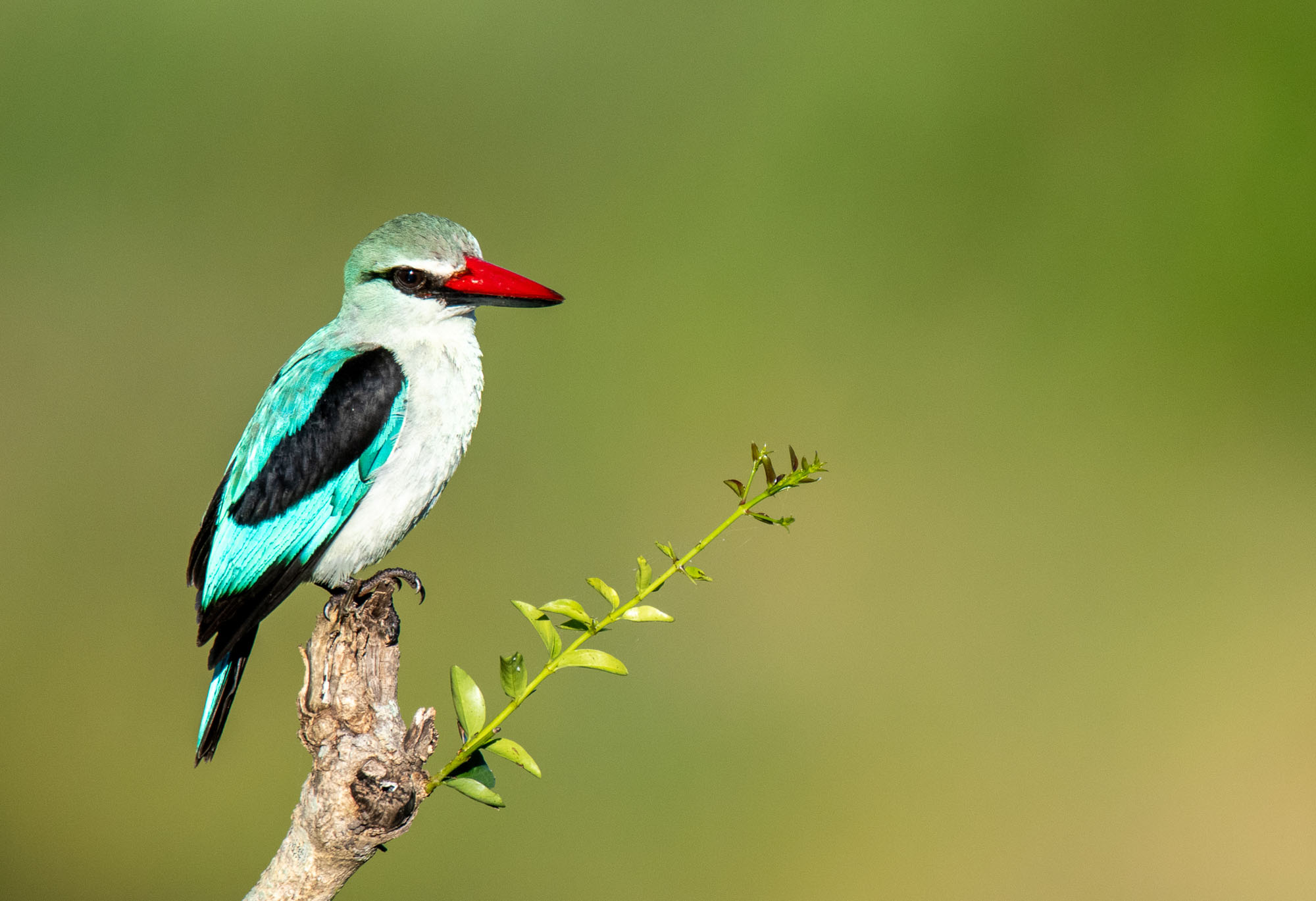
Kingfishers
Africa has less than a tenth of the world’s total number of kingfishers, but these highly visible, charismatic birds are sure to draw the attention of any visitor on safari, anywhere on the continent. While many kingfishers live up to their name and actually hunt for and eat fish, many of them do not. In fact, several species of kingfishers which you are likely to see in Southern or East Africa, are totally non-aquatic, woodland birds. The most striking of these being the Woodland Kingfisher, a simply gorgeous blue and white bird with a vivid red-and-black bill. Its ringing call is an announcement to all and sundry in Southern Africa that summer has arrived, the bird being a seasonal migrant. Other frequently seen insectivorous kingfishers include the Brownheaded, Striped, and Grey-hooded Kingfisher. None of these are quite as flashy as the Woodland Kingfisher, but they have their distinctive appeal.

Of the ‘true’ kingfishers, the ones that attract the most attention are the Malachite, Giant and Pied Kingfisher. The Malachite is a veritable tiny flying jewel, a bedazzled midget flashing along many an African waterway, usually seen when perched on a reed or twig not more than about three to four feet over the water. When approached carefully, it will often stay put, allowing for some ‘brilliant’ images. We’ve taken several of those over the years! Hopefully you will be able to do the same on your own trip.
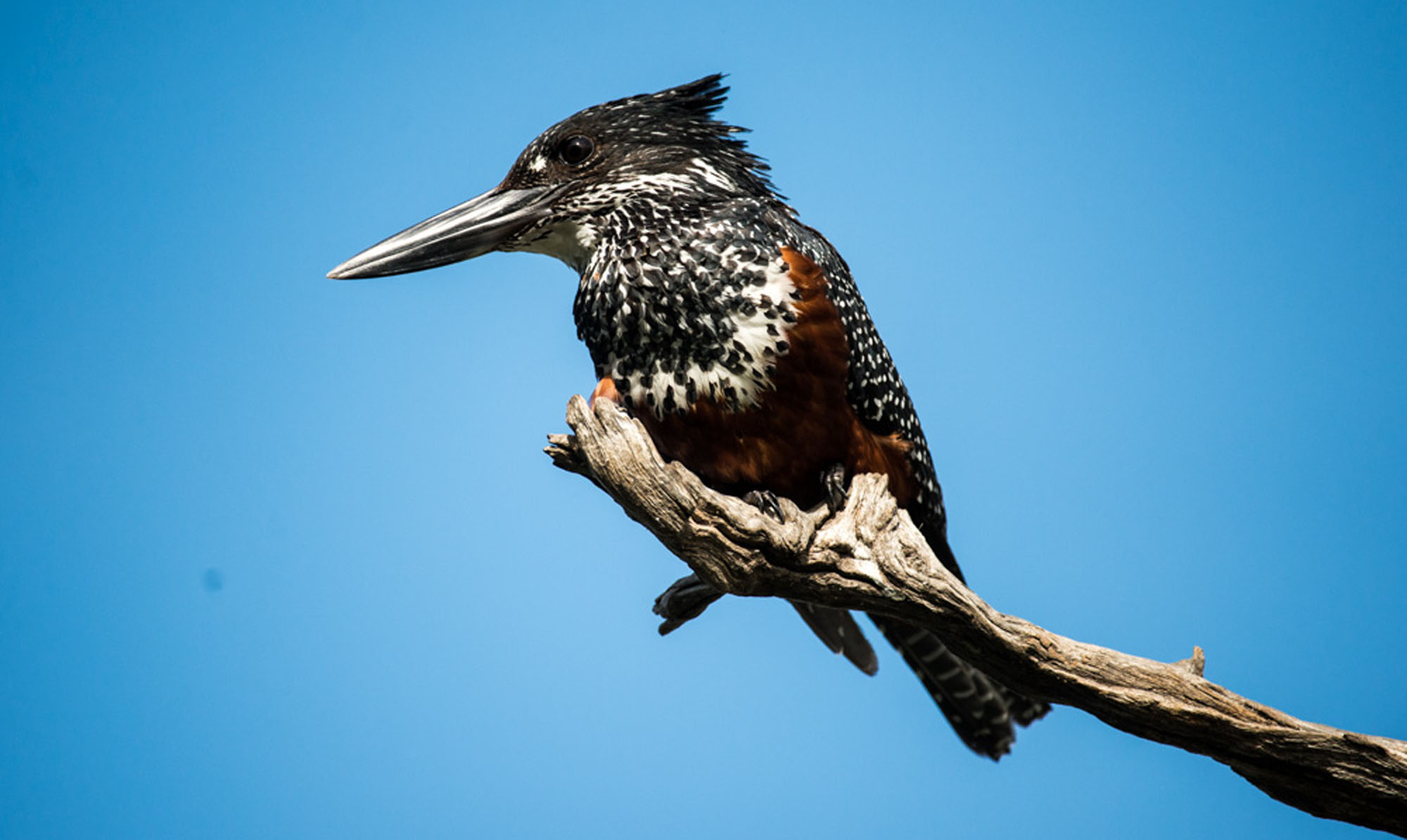
The Giant Kingfisher is hard to miss when around, being several times the size of most of the other aquatic kingfishers. Being the biggest African kingfisher with a shaggy crest, massive bill and with a prominent chestnut breast band (males) or white-spotted black breast band (females), these birds are usually quite easy to see and identify where present. They are not particularly shy either, often perching prominently on sticks or posts, in search of fish, frogs and crabs.
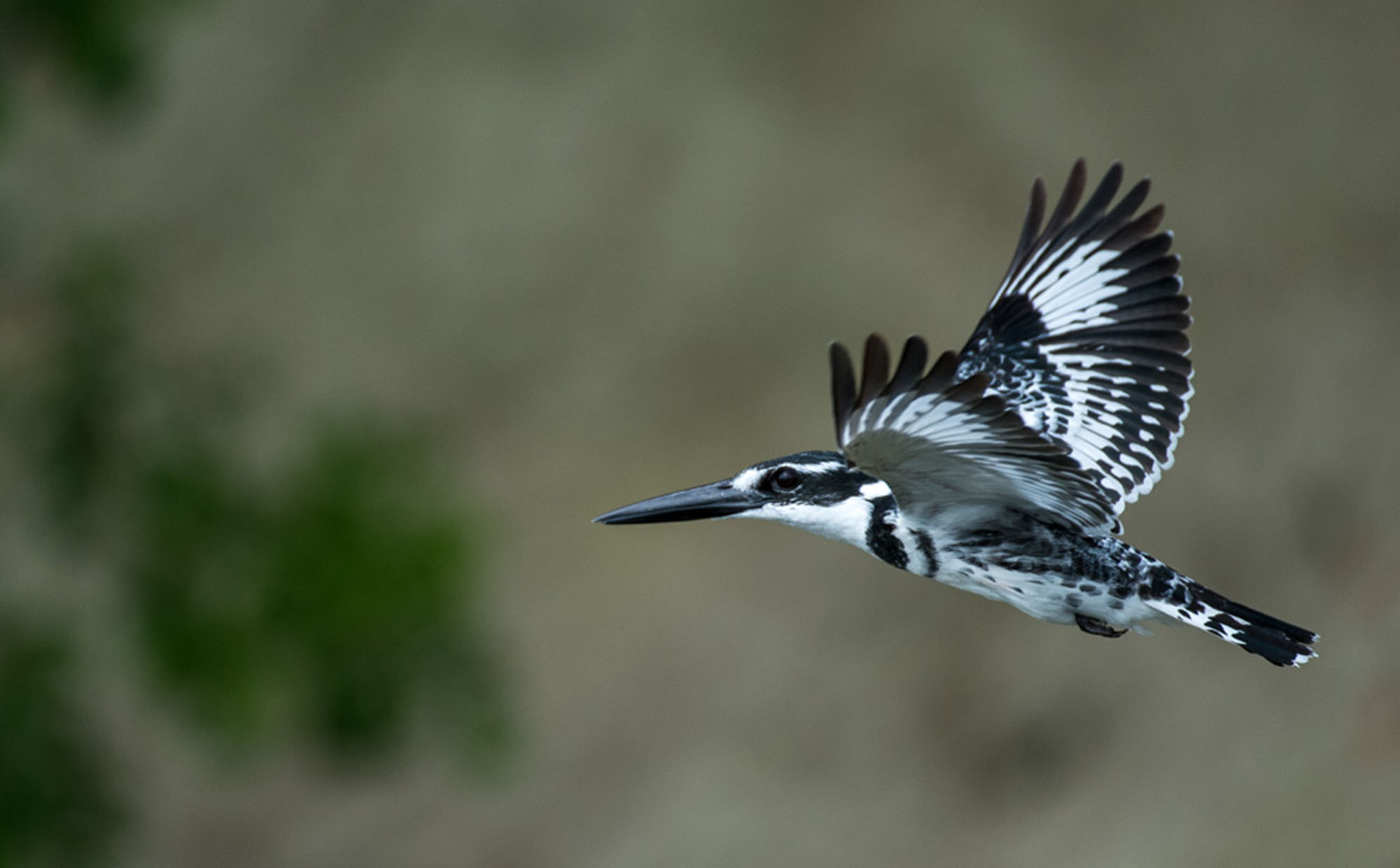
Pied Kingfishers are probably the most commonly observed of any of the African Kingfishers, simply because they are such show-offs. At almost any body of water in sub-Saharan Africa, there will be a pair and sometimes several pairs of Pied Kingfishers, loudly calling out to each other and proclaiming their presence to would-be intruders. These medium-sized, head-bobbing black and white kingfishers are often seen hovering over the water prior to diving vertically and pouncing on a small fish or other prey animal. When successful, they will sometimes devour smaller organisms while flying back to their perch, or otherwise take it with them to be beaten against the post or twig, before being swallowed.
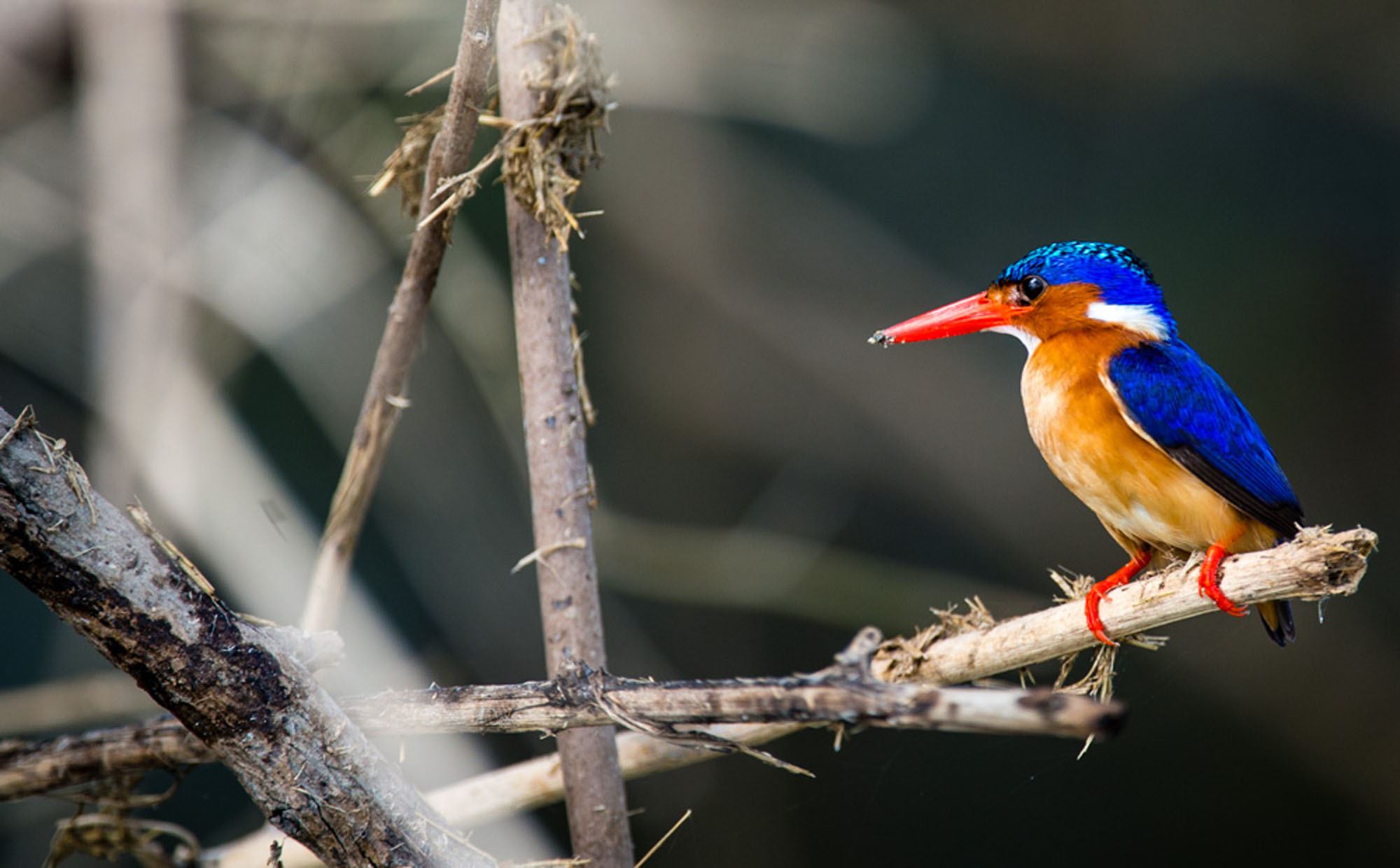
In the third instalment of our ‘Beautiful Birds of Africa’ blog next Friday, we will be looking at some of the most colorful of African birds such as the bee-eaters, rollers, hoopoes, barbets, flycatchers, shrikes, oxpeckers and sunbirds.





